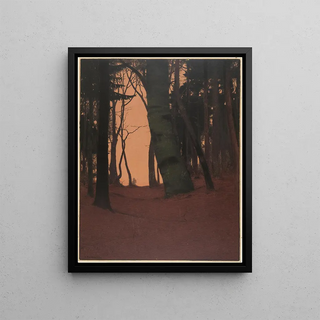Art print | Evening in the Forest - Gustav Kampmann Source: Reproduction | Soirée dans la forêt - Gustav Kampmann


View from behind

Frame (optional)
In the fascinating world of art, some works stand out for their ability to capture the essence of a fleeting moment, to immortalize an atmosphere, or to evoke deep emotions. "Evening in the Forest - Gustav Kampmann" is one of these creations. This painting, which immerses us in an enchanting landscape, invites us on a contemplative walk into the heart of nature. The soft light of dusk, the silhouettes of trees, and the delicacy of the colors blend harmoniously, creating a living tableau that seems to breathe. Observing this piece, one feels an immediate connection with the natural world, a reminder of the beauty that often surrounds us without our paying attention.
Style and uniqueness of the work
Gustav Kampmann's style is characterized by a unique sensitivity to light and color. In "Evening in the Forest," he manages to translate the ephemeral beauty of a sunset through delicate nuances and subtle contrasts. The warm hues of orange and pink blend into the deep green of the foliage, while shadows gently stretch, creating an almost magical atmosphere. Kampmann uses fluid brushstrokes that bring the scene to life, allowing viewers to lose themselves in the depth of the forest. This art print is not just a representation of nature; it is an invitation to feel, to contemplate, and to marvel at the splendor of the natural world—a sensory experience that transcends mere observation.
The artist and his influence
Gustav Kampmann, although less known than some of his contemporaries, has left an indelible mark on the art world. His intuitive approach to painting and his love for nature made him a respected artist within the Impressionist movement. Influenced by great masters, he developed a style that is uniquely his own, combining refined technique with emotional sensitivity. Kampmann often explored themes of nature and light, seeking to capture the fleeting beauty of landscapes. His work, both personal and universal, continues to inspire many contemporary artists, reminding

Matte finish

View from behind

Frame (optional)
In the fascinating world of art, some works stand out for their ability to capture the essence of a fleeting moment, to immortalize an atmosphere, or to evoke deep emotions. "Evening in the Forest - Gustav Kampmann" is one of these creations. This painting, which immerses us in an enchanting landscape, invites us on a contemplative walk into the heart of nature. The soft light of dusk, the silhouettes of trees, and the delicacy of the colors blend harmoniously, creating a living tableau that seems to breathe. Observing this piece, one feels an immediate connection with the natural world, a reminder of the beauty that often surrounds us without our paying attention.
Style and uniqueness of the work
Gustav Kampmann's style is characterized by a unique sensitivity to light and color. In "Evening in the Forest," he manages to translate the ephemeral beauty of a sunset through delicate nuances and subtle contrasts. The warm hues of orange and pink blend into the deep green of the foliage, while shadows gently stretch, creating an almost magical atmosphere. Kampmann uses fluid brushstrokes that bring the scene to life, allowing viewers to lose themselves in the depth of the forest. This art print is not just a representation of nature; it is an invitation to feel, to contemplate, and to marvel at the splendor of the natural world—a sensory experience that transcends mere observation.
The artist and his influence
Gustav Kampmann, although less known than some of his contemporaries, has left an indelible mark on the art world. His intuitive approach to painting and his love for nature made him a respected artist within the Impressionist movement. Influenced by great masters, he developed a style that is uniquely his own, combining refined technique with emotional sensitivity. Kampmann often explored themes of nature and light, seeking to capture the fleeting beauty of landscapes. His work, both personal and universal, continues to inspire many contemporary artists, reminding






